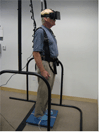Evaluation of Postural Control in Patients with Glaucoma Using a Virtual Reality Environment
- PMID: 25892017
- PMCID: PMC4446143
- DOI: 10.1016/j.ophtha.2015.02.010
Evaluation of Postural Control in Patients with Glaucoma Using a Virtual Reality Environment
Abstract
Purpose: To evaluate postural control using a dynamic virtual reality environment and the relationship between postural metrics and history of falls in patients with glaucoma.
Design: Cross-sectional study.
Participants: The study involved 42 patients with glaucoma with repeatable visual field defects on standard automated perimetry (SAP) and 38 control healthy subjects.
Methods: Patients underwent evaluation of postural stability by a force platform during presentation of static and dynamic visual stimuli on stereoscopic head-mounted goggles. The dynamic visual stimuli presented rotational and translational ecologically valid peripheral background perturbations. Postural stability was also tested in a completely dark field to assess somatosensory and vestibular contributions to postural control. History of falls was evaluated by a standard questionnaire.
Main outcome measures: Torque moments around the center of foot pressure on the force platform were measured, and the standard deviations of the torque moments (STD) were calculated as a measurement of postural stability and reported in Newton meters (Nm). The association with history of falls was investigated using Poisson regression models. Age, gender, body mass index, severity of visual field defect, best-corrected visual acuity, and STD on dark field condition were included as confounding factors.
Results: Patients with glaucoma had larger overall STD than controls during both translational (5.12 ± 2.39 Nm vs. 3.85 ± 1.82 Nm, respectively; P = 0.005) and rotational stimuli (5.60 ± 3.82 Nm vs. 3.93 ± 2.07 Nm, respectively; P = 0.022). Postural metrics obtained during dynamic visual stimuli performed better in explaining history of falls compared with those obtained in static and dark field condition. In the multivariable model, STD values in the mediolateral direction during translational stimulus were significantly associated with a history of falls in patients with glaucoma (incidence rate ratio, 1.85; 95% confidence interval, 1.30-2.63; P = 0.001).
Conclusions: The study presented and validated a novel paradigm for evaluation of balance control in patients with glaucoma on the basis of the assessment of postural reactivity to dynamic visual stimuli using a virtual reality environment. The newly developed metrics were associated with a history of falls and may help to provide a better understanding of balance control in patients with glaucoma.
Copyright © 2015 American Academy of Ophthalmology. Published by Elsevier Inc. All rights reserved.
Figures




Similar articles
-
Fear of falling and postural reactivity in patients with glaucoma.PLoS One. 2017 Dec 6;12(12):e0187220. doi: 10.1371/journal.pone.0187220. eCollection 2017. PLoS One. 2017. PMID: 29211742 Free PMC article.
-
[Postural changes in patients with visual deficits].J Fr Ophtalmol. 2019 Dec;42(10):1078-1084. doi: 10.1016/j.jfo.2019.05.034. Epub 2019 Jun 28. J Fr Ophtalmol. 2019. PMID: 31262594 French.
-
Visual impairment and postural sway among older adults with glaucoma.Optom Vis Sci. 2008 Jun;85(6):489-97. doi: 10.1097/OPX.0b013e31817882db. Optom Vis Sci. 2008. PMID: 18521027
-
The contribution of postural balance analysis in older adult fallers: A narrative review.J Bodyw Mov Ther. 2016 Apr;20(2):409-17. doi: 10.1016/j.jbmt.2015.12.008. Epub 2015 Dec 18. J Bodyw Mov Ther. 2016. PMID: 27210860 Review.
-
Virtual reality applications in improving postural control and minimizing falls.Conf Proc IEEE Eng Med Biol Soc. 2006;2006:2694-7. doi: 10.1109/IEMBS.2006.260751. Conf Proc IEEE Eng Med Biol Soc. 2006. PMID: 17946975 Review.
Cited by
-
The Role of Retinal Imaging and Portable Screening Devices in Tele-ophthalmology Applications for Diabetic Retinopathy Management.Curr Diab Rep. 2016 Dec;16(12):132. doi: 10.1007/s11892-016-0827-2. Curr Diab Rep. 2016. PMID: 27841014 Review.
-
Advanced glaucoma at diagnosis: current perspectives.Eye (Lond). 2020 Jan;34(1):116-128. doi: 10.1038/s41433-019-0637-2. Epub 2019 Nov 18. Eye (Lond). 2020. PMID: 31740802 Free PMC article. Review.
-
Wayfinding and Glaucoma: A Virtual Reality Experiment.Invest Ophthalmol Vis Sci. 2017 Jul 1;58(9):3343-3349. doi: 10.1167/iovs.17-21849. Invest Ophthalmol Vis Sci. 2017. PMID: 28687845 Free PMC article.
-
What rates of glaucoma progression are clinically significant?Expert Rev Ophthalmol. 2016;11(3):227-234. doi: 10.1080/17469899.2016.1180246. Epub 2016 May 13. Expert Rev Ophthalmol. 2016. PMID: 29657575 Free PMC article.
-
Deterioration of postural control due to the increase of similarity between center of pressure and smooth-pursuit eye movements during standing on one leg.PLoS One. 2022 Oct 13;17(10):e0276119. doi: 10.1371/journal.pone.0276119. eCollection 2022. PLoS One. 2022. PMID: 36227896 Free PMC article.
References
-
- Fatalities and injuries from falls among older adults--United States, 1993–2003 and 2001–2005. MMWR Morb Mortal Wkly Rep. 2006;55:1221–1224. - PubMed
-
- Nevitt MC, Cummings SR, Kidd S, Black D. Risk factors for recurrent nonsyncopal falls. A prospective study. JAMA. 1989;261:2663–2668. - PubMed
-
- O'Loughlin JL, Robitaille Y, Boivin JF, Suissa S. Incidence of and risk factors for falls and injurious falls among the community-dwelling elderly. Am J Epidemiol. 1993;137:342–354. - PubMed
-
- Maki BE, McIlroy WE. Postural control in the older adult. Clin Geriatr Med. 1996;12:635–658. - PubMed
-
- Maki BE, Holliday PJ, Topper AK. A prospective study of postural balance and risk of falling in an ambulatory and independent elderly population. J Gerontol. 1994;49:M72–M84. - PubMed
Publication types
MeSH terms
Grants and funding
LinkOut - more resources
Full Text Sources
Other Literature Sources
Medical
Research Materials
Miscellaneous

